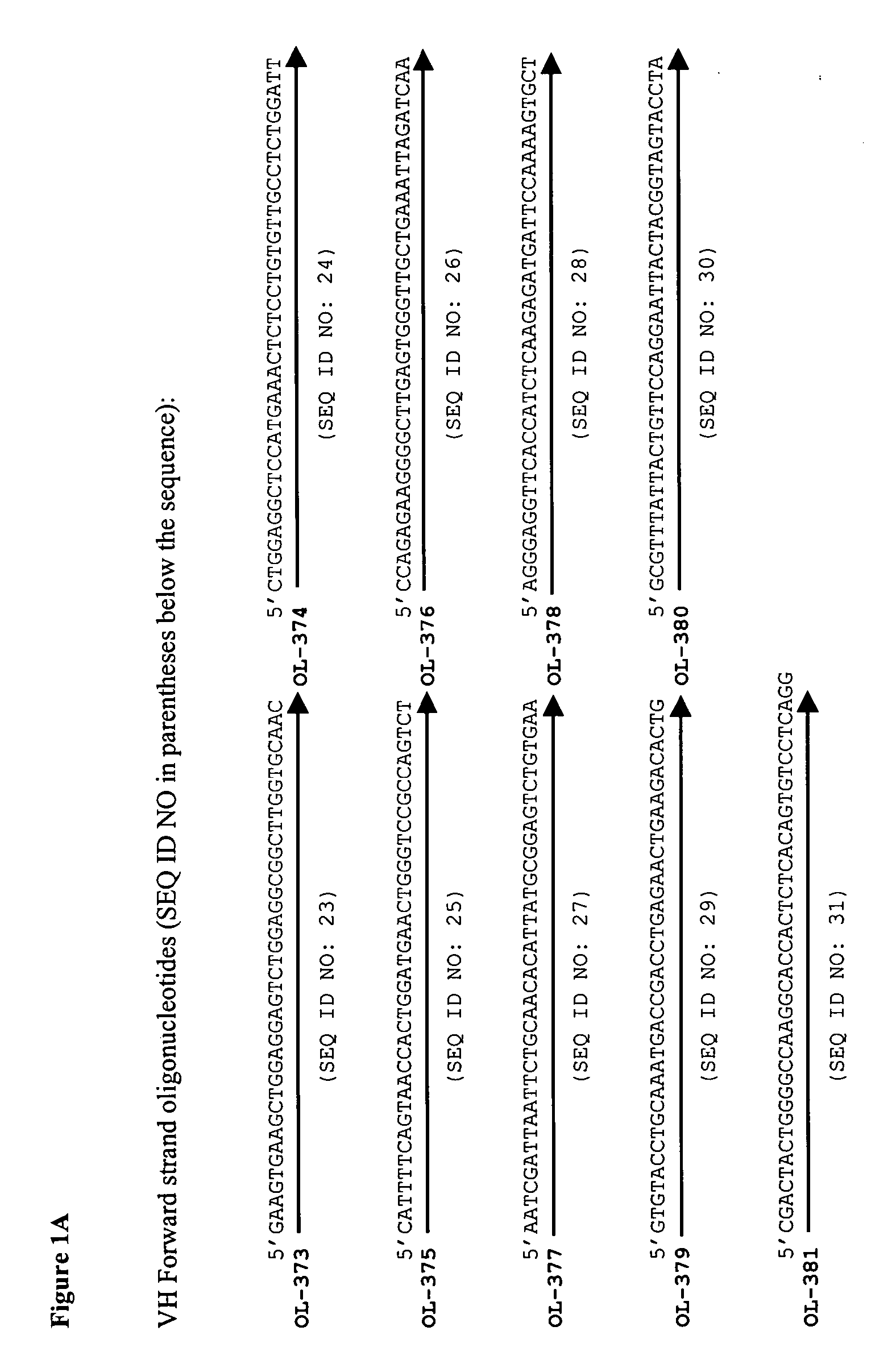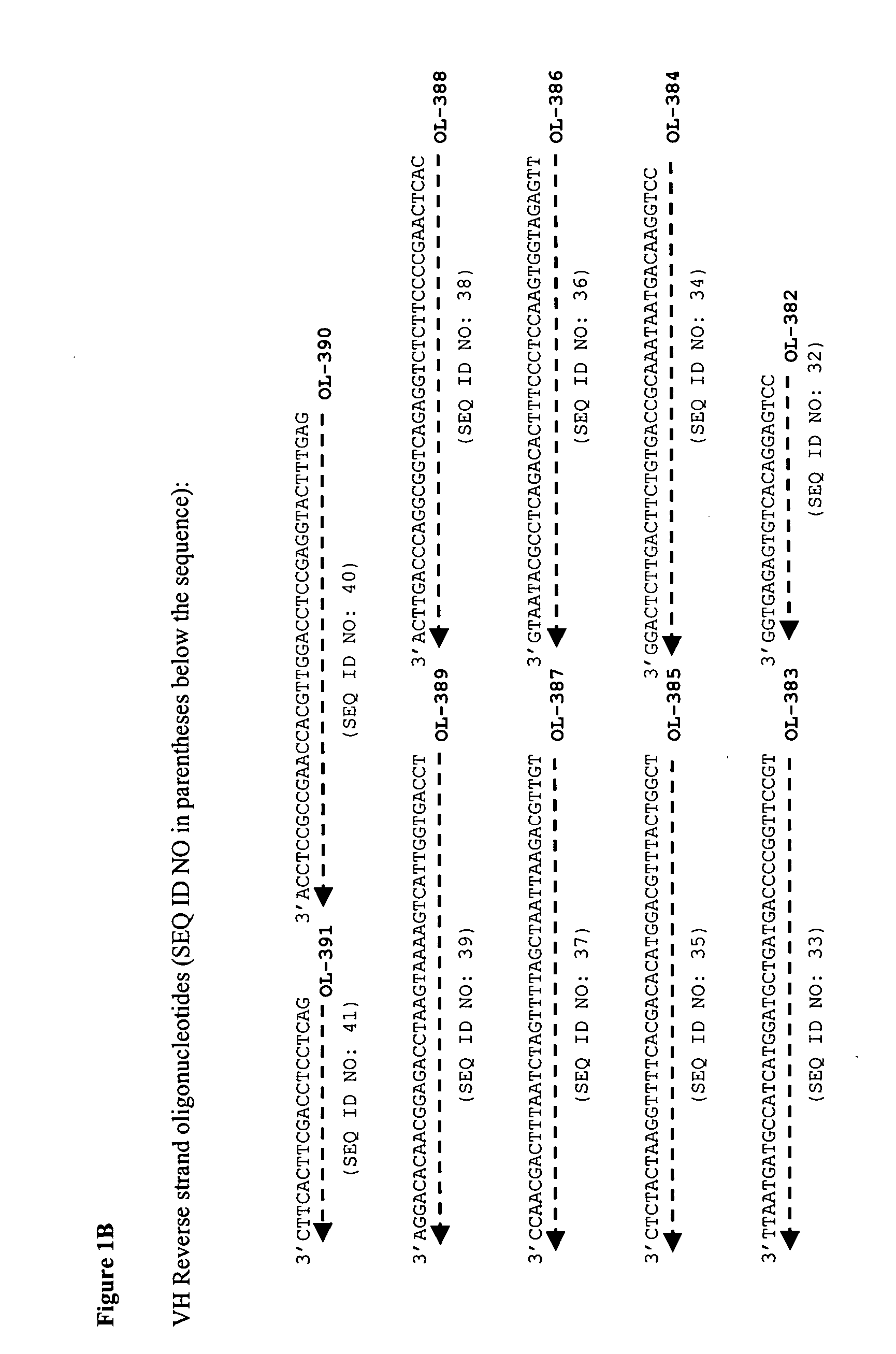TNF alpha-binding polypeptide compositions and methods
a polypeptide and alpha-binding technology, applied in the field of polypeptide compositions, can solve the problems of limited therapeutic value, peptides predicted to be capable of binding mhc class ii molecules may not function as t cell epitopes in all situations, and computational approaches to t cell epitope prediction generally have not been able to predict epitopes with dp or dq restriction. , to achieve the effect of less immunogenicity
- Summary
- Abstract
- Description
- Claims
- Application Information
AI Technical Summary
Benefits of technology
Problems solved by technology
Method used
Image
Examples
example 1
Identification of Potential MHC Class II Ligands in Anti-TNF Alpha VH and VL Protein Sequence by Computational Means.
[0095] A preferred method for the analysis of peptide sequences with potential to act as MHC Class II binding ligands has been described in detail in WO 02 / 069232, the relevant disclosure of which is incorporated herein by reference. A software tool using this procedure has been developed and applied to the analysis of the anti-TNF alpha antibody V-region domains. The software includes a library of model MHC Class II molecules, encompassing a wide number of allotypic variants extant in the human population, and a library of peptide backbone structures, encompassing theoretical and known backbone conformations. Using these libraries, a large data set was generated based on the results of computationally docking each backbone conformation within each model MHC allotype binding groove. The data set includes the best side-chain conformation for all possible amino acids ...
example 2
Identification of T Cell Epitopes using Synthetic Peptides and Naive Human PBMC In Vitro Proliferation Assays.
[0097] The interaction between MHC, peptide and T cell receptor (TCR) provides the structural basis for the antigen specificity of T cell recognition. T cell proliferation assays evaluate the binding of peptides to MHC and the recognition of MHC / peptide complexes by the TCR. The in vitro T cell proliferation assays of the present example involve the stimulation of peripheral blood mononuclear cells (PBMCs), containing antigen presenting cells (APCs) and T cells. Stimulation is conducted in vitro using synthetic peptide antigens, and in some experiments whole protein antigen. Stimulated T cell proliferation is measured by determining the amount of 3H-thymidine (3H-Thy) incorporated in the cells using scintillation counting of washed, fixed cells.
[0098] Buffy coats from human blood stored for less than 12 hours were obtained from the National Blood Service (Addenbrooks Hosp...
example 3
Construction of Anti-TNF Alpha Antibody VH and VL Genes.
[0104] The sequences of the A2 antibody variable regions were derived from U.S. Pat. No. 5,656,272 (see FIGS. 16a and 16b of U.S. Pat. No. 5,656,272). A gene (VH gene; SEQ ID NO: 160; FIG. 15) encoding the variable domain heavy chain of A2 (SEQ ID NO: 9) and a human IgG1 constant domain (SEQ ID NO: 164) was prepared by standard DNA synthesis techniques. The amino acid residue sequence encoded by the VH gene is shown in FIG. 16, SEQ ID NO: 161. A gene (VL gene; SEQ ID NO: 162; FIG. 17) encoding the variable domain light chain of A2 (SEQ ID NO: 10) and a human kappa constant domain (SEQ ID NO: 165) also was prepared by standard DNA synthesis techniques. The amino acid residue sequence encoded by the VL gene is shown in FIG. 18, SEQ ID NO: 163.
[0105] In preparing the genes, a panel of synthetic oligonucleotides were designed and synthesized, and the genes were assembled using a ligase chain reaction (LCR) in which oligonucleoti...
PUM
| Property | Measurement | Unit |
|---|---|---|
| molecular weight | aaaaa | aaaaa |
| molecular weight | aaaaa | aaaaa |
| volume | aaaaa | aaaaa |
Abstract
Description
Claims
Application Information
 Login to View More
Login to View More - R&D
- Intellectual Property
- Life Sciences
- Materials
- Tech Scout
- Unparalleled Data Quality
- Higher Quality Content
- 60% Fewer Hallucinations
Browse by: Latest US Patents, China's latest patents, Technical Efficacy Thesaurus, Application Domain, Technology Topic, Popular Technical Reports.
© 2025 PatSnap. All rights reserved.Legal|Privacy policy|Modern Slavery Act Transparency Statement|Sitemap|About US| Contact US: help@patsnap.com



